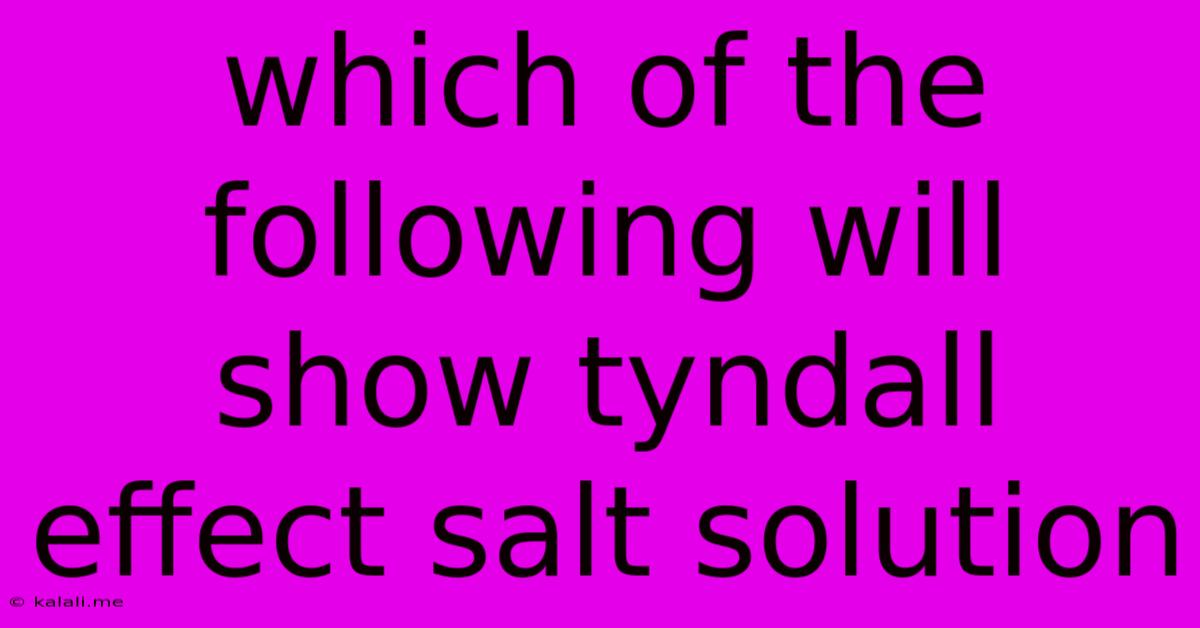Which Of The Following Will Show Tyndall Effect Salt Solution
Kalali
Jun 11, 2025 · 2 min read

Table of Contents
Does a Salt Solution Show the Tyndall Effect? Unveiling the Science Behind Light Scattering
The Tyndall effect is a fascinating phenomenon where a beam of light becomes visible as it passes through a colloid. This scattering of light is caused by the interaction of light waves with particles larger than the wavelength of visible light. But does this apply to a simple salt solution? Let's delve into the science to find the answer. This article will explain the Tyndall effect, differentiate between solutions and colloids, and definitively answer whether a salt solution exhibits this light-scattering phenomenon.
Understanding the Tyndall Effect:
The Tyndall effect is named after Irish physicist John Tyndall, who first described this observation. It's a crucial tool in differentiating between solutions and colloids. When a light beam passes through a true solution (like salt dissolved in water), the particles are too small to scatter light significantly. The light passes through unimpeded, remaining invisible. However, in a colloid, the dispersed particles are larger, causing the light to scatter in all directions, making the beam visible. Think of a sunbeam piercing through dusty air – that's the Tyndall effect in action.
Solutions vs. Colloids: Key Differences:
To understand why a salt solution doesn't show the Tyndall effect, we need to understand the fundamental difference between solutions and colloids:
-
Solution: A homogeneous mixture where a solute (like salt) is completely dissolved in a solvent (like water). The solute particles are individual ions or molecules, far smaller than the wavelength of visible light.
-
Colloid: A heterogeneous mixture containing particles larger than those in a solution but smaller than those in a suspension. These particles are dispersed throughout the medium but don't settle out over time. Examples include milk, fog, and ink.
Why Salt Solution Doesn't Exhibit the Tyndall Effect:
When salt (NaCl) dissolves in water, it dissociates into its constituent ions: Na⁺ and Cl⁻. These ions are incredibly small, much smaller than the wavelength of visible light. Because of their minuscule size, they don't effectively scatter light. Therefore, a beam of light passing through a salt solution will remain invisible; the Tyndall effect is not observed.
Substances That DO Exhibit the Tyndall Effect:
Several substances readily demonstrate the Tyndall effect due to their colloidal nature. Examples include:
- Milk: A colloid of fat globules in water.
- Fog: A colloid of water droplets in air.
- Gelatin: A colloid of protein molecules in water.
- Blood: A complex colloid containing various cells and proteins.
Conclusion:
In summary, a salt solution will not show the Tyndall effect. This is because the dissolved salt ions are too small to scatter visible light. The Tyndall effect is a reliable indicator of colloidal systems, where larger particles effectively scatter light, making the light beam visible. Understanding the difference between solutions and colloids is crucial in interpreting this fascinating optical phenomenon.
Latest Posts
Latest Posts
-
What Is The Difference Between A River And Lake
Jun 13, 2025
-
Least Common Multiple Of 30 And 8
Jun 13, 2025
-
All Of The Following Are Major Components Of Soil Except
Jun 13, 2025
-
Which Of The Following Best Describes A Blog
Jun 13, 2025
-
What Is The Blinking Line Called When Typing
Jun 13, 2025
Related Post
Thank you for visiting our website which covers about Which Of The Following Will Show Tyndall Effect Salt Solution . We hope the information provided has been useful to you. Feel free to contact us if you have any questions or need further assistance. See you next time and don't miss to bookmark.